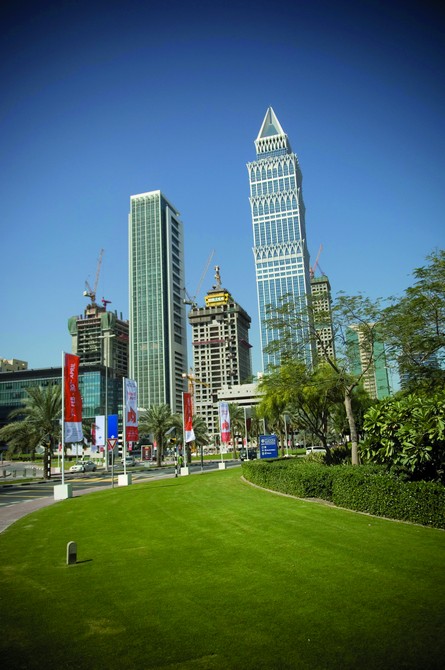Building Its Own Future
To say the Middle East is undergoing a boom would be a feeble understatement. Much of Dubai is one big construction site, with cranes, half-built skyscrapers and dug-up roads as it races headlong in its bid tobecome a global city: a crossroads of commerce and a leisure paradise of theme parks, man-made islands shaped like the world and arguably the most iconic hotel anywhere.Its national airline Emirates, launched two decades ago, is now one of the world's most important carriers, with a fleet of 108 Airbuses and Boeings and orders for 191 more, including 58 A380s.
 |
|---|
© Billypix |
Down the highway, oil-rich Abu Dhabi has more restrained ambitions, but is determined to become the cultural capital of the region with a host of large-scale infrastructure projects. With its new airline Etihad carrying the flag for the UAE capital and a new international airport in the works, Abu Dhabi is determined not to let its more flamboyant neighbour - building the world's biggest airport in the desert at Jebel Ali - have all the glory.
Qatar - one of the world's biggest producers of natural gas - is diversifying its economy through the vehicle of aviation, with Qatar Airways tasked with marketing the Qatar brand throughout its growing global network. In Qatar's capital Doha also a sparkling new airport is being constructed to cater for the millions of tourists and investors expected to journey to or pass through the tiny Gulf kingdom in the next decade. The UAE's smaller emirates, together with the other GCC nations - Bahrain, Kuwait, Oman and the biggest, Saudi Arabia - are all investing to varying degrees in their aviation industries.
Beyond the Gulf, impoverished Jordan is marketing its low labour costs as a centre for the aerospace light engineering and support sector, while troubled neighbours Iraq and Lebanon see aviation links as a way of delivering much-needed investors and visitors. Every time an aircraft deposits tourists at one of Egypt's resorts, it brings the country much-needed foreign revenues.
The aggressive hub strategies of airlines such as Emirates, Etihad and Qatar have seen much of the world's long-haul traffic transit through their once-sleepy airports. The region's seemingly unbridled economic expansion also means millions of passengers - from investment bankers and tourists to the humblest street-sweeping guest worker - begin and end their journeys by airliner. While some doubt the ambitious expansion plans of the region's airlines are sustainable - given the uncertainty in the world economy - the aerospace industry has a lot hanging on its continuing success. GCC airlines account for over 9% of Airbus and Boeing backlogs and almost 19% of widebody orders, according to Flight's ACAS database. Visiting the region, there is no sense that those big-spending carriers are looking to rein in their ambitions.
Central Location
Business aviation too - into and within the region - has boomed, with high net worthindividuals from around the world making the most of the UAE's central location as well as its liberal regulatory and tax regimes by basing their jets there. A flurry of new business aviation specialists have emerged in the past five years, including Abu Dhabi's Royal Jet - the world's biggest operator of Boeing Business Jets - and Falcon Aviation. Many of the region's corporations have invested in their own aircraft.
What all these countries lack is enough skilled aviation professionals to fulfil their ambitions, and the problem is most acute in the UAE, where despite a long-running programme to bring more nationals into professions such as piloting and aerospace engineering, expatriates greatly outnumber locals (some 12% of Emirates pilots, for instance, are nationals). Although both Emirates and Etihad have launched programmes to attract more Emiratis into their ranks, efforts have by necessity been focused more at the junior levels, with schemes for cadet first officers and apprentice aircraft technicians. Experienced professionals still need to be recruited largely from the English-speaking world: the UK, North America, Australasia and South Africa.
"The market is like a sponge at the moment. It can absorb anything," says Phil Newton of recruitment consultancy Touch Aviation, which specialises in the Middle East. So much so, that it is becoming a sellers' market, with companies battling over the most experienced recruits and they, in turn, being able to set their own terms and play potential employers off against eachother.
"A lot of these places are vying for the same people," says Newton. "And aviation is not like construction, where you need one engineer for every 100 labourers. It's a market where everybody is tapping the same limited global pool of skills."
Balanced against this is the rising cost of living in a region famed for its bargains, cheap petrol and favourable exchange rates. Despite the tax-free packages on offer, the region's overheating economy has sparked inflation, with availability and cost of accommodation in cities such as Dubai and Abu Dhabi a particular problem.
Although apartment blocks and residential complexes are springing up around the edges of Dubai, they are frequently snapped up before the cement mixers leave the site. For those working for big employers such as Emirates and Etihad, this is not such a problem: these companies rent entire buildings to house expatriate staff, including cabin crew.
But for smaller operators, the problem of finding suitable accommodation for their staff can be acute. Expatriates who once might have expected to snap up a villa with a swimming pool close to the seafront, may now have to settle for a two-bedroom flat overlooking a noisy road.
 |
|---|
© Billypix |
Source: Flight International
















